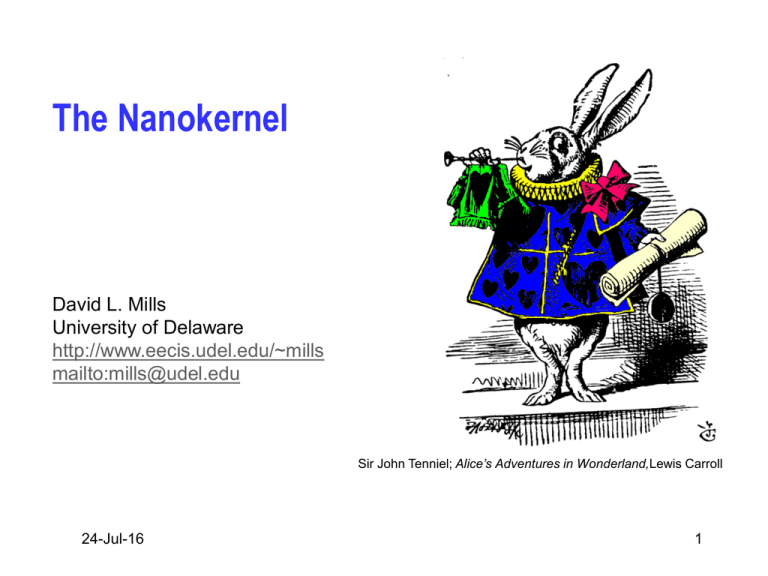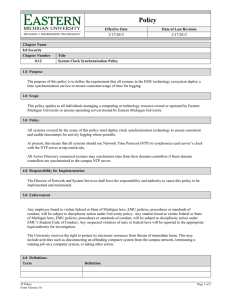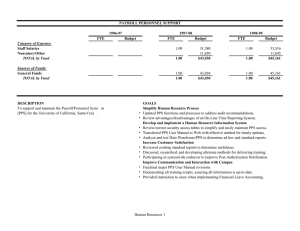The Nanokernel David L. Mills University of Delaware
advertisement

The Nanokernel David L. Mills University of Delaware http://www.eecis.udel.edu/~mills mailto:mills@udel.edu Sir John Tenniel; Alice’s Adventures in Wonderland,Lewis Carroll 24-Jul-16 1 Going faster and faster Observing that – PC and workstation processor clock rates approaching and exceeding 1 GHz are becoming widely deployed – 10-Mb Ethernets have been replaced by 100-MHz Ethernets and these are now being replaced by 1-GHz Ethernets – 1.5-Mb Internet links have been replaced by 43-Mb links and these are being replaced by 155-Mb OC-3 links and soon 2.4-Gb OC-48 links And further that – Timekeeping expectations have been typically tens of milliseconds on a WAN and low milliseconds on a LAN – Timekeeping ambitions for some applications are in the tens of microseconds on a modern workstation We conclude that – Accuracy expectations can be considerably improved by moving the clock discipline code from user space to the kernel and, where available, precision synchronization sources 24-Jul-16 2 Evolution to NTP Version 4 NTP Version 3 was first used in 1992 in a rambunctious Internet of congested links and 25-MHz workstations NTP Version 4 architecture, protocol and algorithms have been evolved for gigabit networks and gigahertz computers – Improved clock models which accurately predict the phase and frequency noise for each synchronization source and network path – Engineered algorithms which reduce the impact of delay spikes and oscillator wander while speeding up initial convergence – Redesigned clock discipline algorithm which can operate in frequency-lock, phase-lock and hybrid modes But, the Unix time adjustment primitive prevents further improvement to the ambition of a few microseconds 24-Jul-16 3 Unix time adjustment primitive q Adjustment Interval s A C +S t -S e Adjustment Rate R - j Frequency Error j B The discipline needs to steer the frequency over the range ±S, but the intrinsic clock frequency error is j Unix adjtime() slews frequency at rate R - j PPM beginning at A Slew continues to B, depending on the programmed frequency steer Offset continues to C with frequency offset due to error j The net error with zero steering is e, which can be several hundred ms 24-Jul-16 4 Computer clock modelling SPARC IPC Pentium 200 Alpha 433 Resolution limit 24-Jul-16 5 Allan intercepts compared System Resolution Precision Stability x Intercept y Intercept Range * SPARC IPC 1000 ns 1000 ns good 2000 s .01 PPM 600 5000 s Pentium 200 1 ns 5 ns poor 50 s .03 PPM 10 300 s Alpha 433 1 ns 2.3 ns good 200 s .005 PPM 50 2000 s Resolution limit 1 ns 1 ns good 2s .0004 PPM 110 s * For stability no worse than twice y intercept 24-Jul-16 6 NTP kernel clock discipline qr+ NTP qc- VFO Vc Phase Detector Vd Clock Filter Loop Filter x Clock Phase/Freq y Adjust Prediction Vs NTP Daemon Kernel Type II, adaptive-parameter, hybrid phase/frequency-lock loop disciplines variable frequency oscillator (VFO) phase and frequency NTP daemon computes phase error Vd = qr - qo between source and VFO, then grooms samples to produce time update Vs Loop filter computes phase x and frequency y corrections and provides new adjustments Vc at 1-s intervals VFO frequency is adjusted at each hardware tick interrupt 24-Jul-16 7 FLL/PLL prediction functions Phase Correct x y yFLL FLL Predict yPLL PLL Predict Vs S Vs is the phase offset produced by the clock filter algorithm x is the phase correction computed as a fraction of Vs yFLL is the frequency adjustment computed as the average of past frequency offsets yPLL is the frequency adjustment computed as the integral of past phase offsets yFLL and yPLL are combined according to weight factors determined by poll interval and Allan deviation characteristic 24-Jul-16 8 Nanokernel architecture x Clock Oscillator Tick Interrupt Phase Prediction PLL/FLL Discipline NTP Update Frequency Prediction PPS Discipline PPS Interrupt Calculate Adjustment Second Overflow y PLL/FLL discipline predicts phase x and frequency y at measurement intervals from 1 s to over one day PPS discipline predicts phase and frequency at averaging intervals from 4 s to 256 s, depending on nominal Allan intercept On overflow of the clock second, a new value is calculated for the tick interrupt adjustment Tick adjustment is added to the system clock at every tick interrupt Process cycle counter (PCC) used to interpolate microseconds or nanoseconds between tick interrupts 24-Jul-16 9 PPS phase and frequency discipline Second Offset PPS Interrupt Median Filter Range Checks Phase Average x Ambiguity Resolve Range Checks Frequency Average y Frequency Discrim PCC Counter Phase and frequency disciplined separately - phase from system clock offset relative to second, frequency from process cycle counter (PCC) Frequency discriminator rejects noise and incorrect frequency sources Median filter rejects sample outlyers and provides error statistic Range checks reject popcorn spikes in phase and frequency Phase offsets exponentially averaged with variable time constant Frequency offsets averaged over variable interval 24-Jul-16 10 Experimental results with PPS discipline Hepzibah is a 400-MHz Pentium workstation with a GPS receiver The PPS signal is connected via parallel port and modified driver Rackety is a 25-MHz SPARC IPC dedicated NTP server with dual redundant GPS receivers and dual redundant WWVB receivers This machine has over 1000 clients causing a load of 15 packets/sec The PPS signal is connected via serial port and modified driver Churchy is a 433-MHz Alpha workstation with a GPS receiver This machine uses a SAW oscillator presumed spectrally pure The PPS signal is connected via serial port and modified driver All machines accessed the PPS signal from a GPS receiver and a level converter where necessary Experiments lasted one day with data collected by the NTP daemon 24-Jul-16 11 PPS time offset characteristic for Hepzibah Jitter is presumed caused by interrupt latencies on the ISA bus We need to explain why the spikes are both positive and negative 24-Jul-16 12 PPS time offset characteristic for Rackety Jitter is presumed caused by interrupt latencies on the Sbus Large negative spikes reflect contention by the radios and network 24-Jul-16 13 PPS time offset characteristic for Churchy Jitter is presumed caused by interrupt latencies on the PCI bus High flicker noise may be due to SAW phase noise and no PLL 24-Jul-16 14 Present status The kernel modifications have been implemented for FreeBSD, Linux, Alpha and SunOS The current version is in current FreeBSD and Linux public distributions An older version, but with resolution only to the microsecond, is in current Alpha and Solaris licensed products A standard PPS application program interface (PPSAPI) has been proposed to the IETF and supported in all kernels 24-Jul-16 15 Further information Network Time Protocol (NTP): http://www.ntp.org/ – Current NTP Version 3 and 4 software and documentation – FAQ and links to other sources and interesting places David L. Mills: http://www.eecis.udel.edu/~mills – Papers, reports and memoranda in PostScript and PDF formats – Briefings in HTML, PostScript, PowerPoint and PDF formats – Collaboration resources hardware, software and documentation – Songs, photo galleries and after-dinner speech scripts FTP server ftp.udel.edu (pub/ntp directory) – Current NTP Version 3 and 4 software and documentation repository – Collaboration resources repository Related project descriptions and briefings – See “Current Research Project Descriptions and Briefings” at http://www.eecis.udel.edu/~mills/status.htm 24-Jul-16 16



